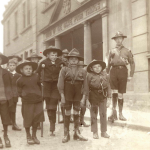Marrying two phases of our History of Place project together, Grace Morgan-Tait and I conducted an oral history interview with Christine, who grew up in Heritage House, Headquarters of the Guild – the primary focus of our exhibit currently featured at the M Shed. Christine is the daughter of the Guild’s last Warden and her memories, opinions and points of view benefit the picture we have been are building of contemporary experiences of disability and related institutions in Bristol.
Earlier in the project we studied archives in the Bristol Record Office to source factual and descriptive content about. The Guild. These included: meeting minutes, building plans, scrapbooks, newsletters, newspaper clippings and sadly minimal first–hand accounts (especially from the service users themselves). Although we gained thought-provoking information about the Guild, from our research we had a gap in our understanding of the daily life experienced there, and only assumptions about how and why it closed.
From our archive research about the Guild we had a gap in our understanding of daily life there, and only assumptions about how and why it closed.
The new chapter of the History of Place project in Bristol is about making sure we capture those previously unheard voices and stories for future generations.
Christine’s story
In answering our questions and sharing her memories, Christine was able to flesh out our knowledge of the Guild. We learnt from oral historian Rib Davis, during our oral history training session at the Vassall Centre, that oral histories are valuable due to their largely unedited nature and ability to tell a wider history, with accents, emotions and hearsay. Rib also highlighted the value of indirect experiences, this was very true with Christine. For example, Christine herself is not disabled but her wealth of experience with Guild members, and her unique childhood perspective makes her a fascinating person to interview with regard to the Guild.
It was exciting for Grace and I, as parts of what Christine said aligned with what we picked up from the archives we previously studied. I know Grace enjoyed relating incidents that had been in the meeting minutes – such as travel arrangements, with anecdotes that Christine could give us about her father driving the van. I saw images in a scrapbook of items made by guild members sold at fairs and it was nice to hear Christine talk about the atmosphere in the crafts room at the Guild.
Overall, my favourite thing Christine shared was her two contrasting memories of trips with the Guild to Bristol Zoo; one as a child riding on the lap of a member in a wheelchair and the second as an adult pushing the wheelchair. Christine said she could remember a member of the public at the Zoo querying whether they were all part of an institution, to which a guild member replied: ‘no, we are a society of friends’.











